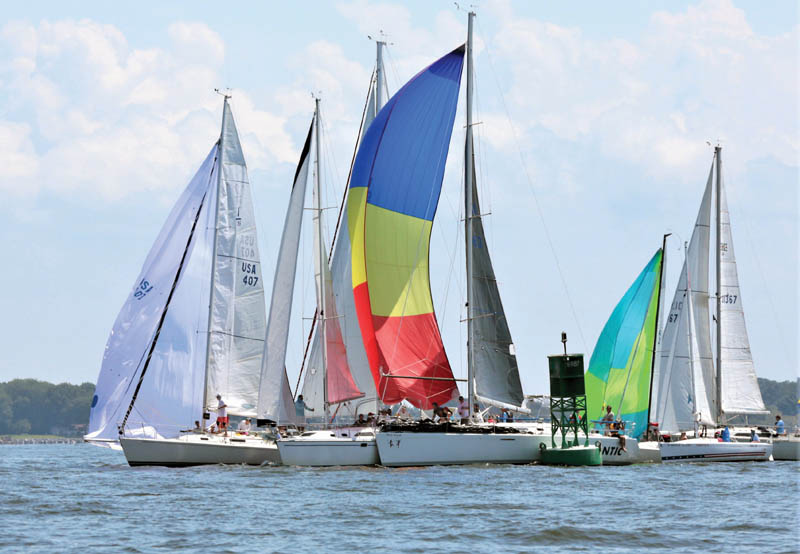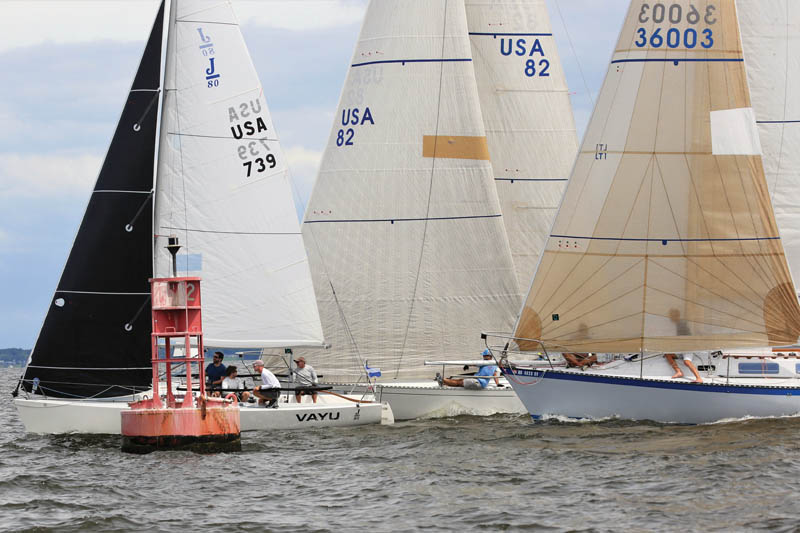Know when to say no!
There are lots of ways to lose a sailboat race or regatta. The gods are fickle. Not only do you have to be fast and have tidy execution of mechanics, but the wind, current, and your competitors also have to cooperate. There are, however, some classic mistakes that will really cost you big that can be avoided. Having made all of them multiple times I consider myself an expert. Keep these big ones in mind and you will not shoot yourself in the foot, even though you might find other ways to snatch defeat from the jaws of victory.

Starting at the boat
It is always cool to win the start at the committee boat. You will feel powerful. The committee will be impressed. It is also easy to have things go horribly wrong. There are two basic ways to get in trouble. The first is to be early with no place to go. Can’t bear off because there are boats below. Can’t sail high and slow enough to kill the necessary time. This is a basic miscalculation of speed, time, and distance. Easy to make. Multiple practice starts prior to the real thing will help with sense of timing and position of lay line, but it is still easy to be off. Other boats trying to start at the same time with their own ideas are also a big factor that cannot necessarily be anticipated.
The second way to get in big trouble is to misjudge the lay line and end up above it. The infamous “barging zone” is an absolute no-no. If any of your fellow competitors have made a better judgement about the lay line, they are not going to let you in; nor do they have to. The response in both cases once you realize that you are (this is a family publication) “in less than optimum position,” is the same. You have to bail out and go around again. The earlier you recognize the situation and commit to action, the better.
If early, go ahead and accelerate. Tack around the committee boat. Gybe in behind the boats who have had better judgement. If caught barging, tack around early before the boat and gybe into your position in line. In both cases you will end up late at the boat in the second or third row. However, you will not have fouled or been over early. The penalties for either of which are far worse. The good news is that you will be able to tack right away for clear air. Also, if you were working to start at the boat that hard, your strategic plan hopefully had you headed to the right side of the beat.
Starting at the pin
You may be beginning to sense a theme here. Starts are hard and easy to get wrong. Starting at the absolute end of line, at either end, raises the risk factor. Once again, there are two ways to get in trouble. You can simply be early and run out of room to kill speed before the pin rears its ugly head. Or, you can end up mis-judging the lay line; easy to do once you mix in the presence of other boats and the bad air they bring. “I think we can make it! I think we can make it! Darn, we didn’t make it.” The worst case: we actually wrap ourselves around the mark. The best case: we are so slow that the rest of the fleet sails right over the top and on by.
The key is to realize that you are in trouble early and commit to taking the tough love. Go around the pin and gybe back around to start correctly, if early. Bear off below the pin, gybe, and start on port. Both of these are quick moves that will lose the least amount of time. Yes, you will be starting behind most of your competitors (except for the stragglers) who started on time on starboard. That is not the end of the world. Don’t let your mistake cause you to lose sight of the big picture.

The port starboard crossing
“Are we crossing? It is close. Might have it. No!” Here, there is a wild duck or a crash tack. All three scenarios, attempting a marginal cross, the last-second duck, or desperate tack involve a high likelihood of a foul. The latter two will be at the very least extremely slow. The downside risk is just not worth it. All your competitor has to say, barring some incredibly fortuitous video evidence, is that they had to alter course to avoid you. Case closed.
It is all about anticipation and understanding your options so that you do not get caught like a deer in the headlights. First option is to tack. You can “lee bow” (tack without fouling and end up just ahead and to leeward), only if you can comfortably cross. If it is close, you have to tack early, well to leeward. Option two is a duck. If you start early with a smooth bear away and are coming up as you cross the port tacker’s transom, you are essentially even and can even build a little speed. The next time you come together you will be on starboard, and “voilà,” you are ahead.
The final option is to ask the port tacker if you can cross. They may wave you across even if they may make a small duck because they do not want you to tack and potentially end up on their air. The option you choose all comes down to the big picture. Where do I want to go? If I am looking to continue to the right side of the course or am riding a big lift on port, a duck is the best option. If it is getting time to be leading back to the middle of the course, tacking is the way to go. This same thought process works downwind as well. The options are gybe or duck and should be predicated on where you are on the racecourse and where you want to go.
Late on port at the weather mark
One of my all-time favorites. You don’t want to get to the lay line early, right? “Can’t cross now—I’ll wait and see if things get better. Oops. They are not getting better, but here I am almost on the port tack lay line. Guess we have to go.” Wow, there are a lot of starboard tackers. Maybe we can jam it in just in front of that next one. (Please remember here that in order to successfully lee bow, you need to be able to cross easily). Darn, tacked too close. Starboard tackers call. All they have to say is they had to alter course, and at the very least, you are in for a long night in the protest room.
Or, even worse, you tack and find you are not quite making it, and all your competitors are yelling at you. Choices? Hit the weather mark or bear off ignominiously and gybe back around to face the same scenario again. If it is close at the weather mark, you have to duck. With better anticipation you might have seen the writing on the wall and tacked earlier to avoid having to duck too many oncoming starboard tackers.
Room at the leeward mark
After starting, the leeward mark rounding is arguably one of the toughest maneuvers to master on the racecourse. The mistake to make is to try to wait until the last possible moment hoping to establish an inside overlap. Not only is the burden on you to prove that you got there prior to the three-boat-length circle, but it will also put huge pressure on your team’s mechanics to pull it off. The potential cluster of half-dropped spinnaker, everyone out of position, bad turn, and poor acceleration as a result should be enough of a deterrent. Concede your position. There is not enough to gain. Take down early for a nice clean rounding. Come in wide and out tight so you have clear air and good acceleration (you can tack if the boat ahead has had a proper rounding).
Universal principles
In each of these five scenarios the over-riding principles are anticipation and the willingness to recognize when things are not going according to plan. Act sooner rather than later. Know what your bail-out options are and go straight to them. He who hesitates is lost.
by David Flynn of Quantum Sails
Questions? Email [email protected]




